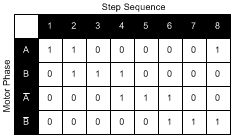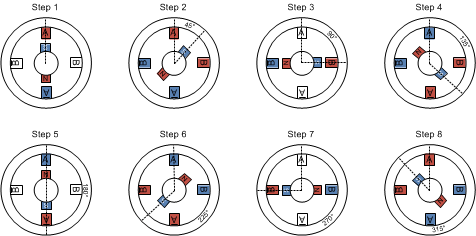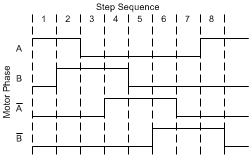SLVA767A September 2016 – December 2016 SN75469 , TPL7407L , TPL9201 , ULN2003A , ULN2003B , ULN2003V12 , ULN2004A , ULQ2003A , ULQ2003A-Q1 , ULQ2004A , ULQ2004A-Q1
4.3 Half-Step Operation
The half-step mode of operation is less commonly used compared to the full-step method, but is typically more common than the wave drive method, as it enables better stepper resolution with the same motor. One disadvantage to the half-step method is that the torque swings between that of the wave drive method and that of the full-step method. Some devices, however, have internal circuitry to limit current and reduce torque ripple when half-stepping. The half-step mode would likely be used in applications where increased resolution is required.
For this mode of operation, two phases of the motor are activated simultaneously followed by a single phase. This ultimately provides additional resolution relative to both the wave drive and full-step methods. Figure 14 and Figure 15 describe the step pattern required for the half-step method, while Figure 16 provides a pictorial representation of the motor steps. Depending on the motor, each step in the sequence will rotate a defined angular distance. Figure 16 represents a motor with 4 steps per revolution, but many common stepper motors will have 32 or 64 steps per revolution; furthermore, others can have even higher precision. Each step for the motor in Figure 16 spins the motor 45°. Note that the half-step method allows for twice the resolution of the full-step method because each step is half that of the full-step method.
 Figure 14. Half-Step Logic Table
Figure 14. Half-Step Logic Table  Figure 16. Half-Step Motor Coil Sequence
Figure 16. Half-Step Motor Coil Sequence  Figure 15. Half-Step Timing Diagram
Figure 15. Half-Step Timing Diagram